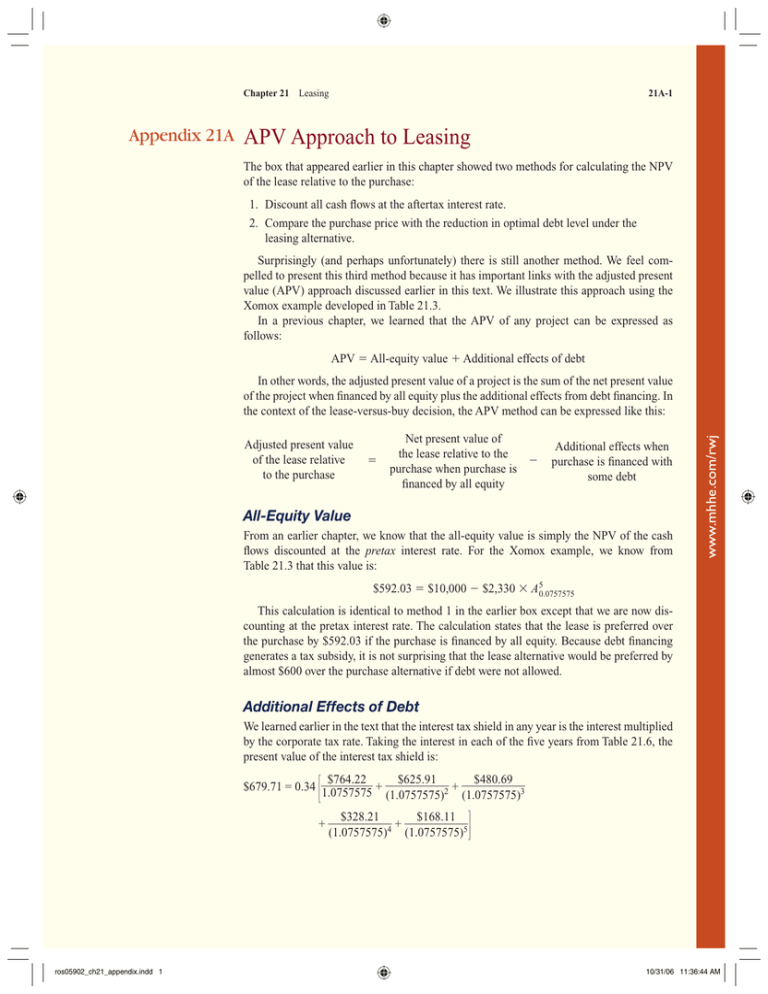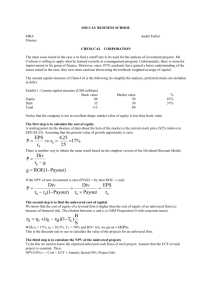APV Approach to Leasing
advertisement

Chapter 21 Appendix 21A Leasing 21A-1 APV Approach to Leasing The box that appeared earlier in this chapter showed two methods for calculating the NPV of the lease relative to the purchase: 1. Discount all cash flows at the aftertax interest rate. 2. Compare the purchase price with the reduction in optimal debt level under the leasing alternative. Surprisingly (and perhaps unfortunately) there is still another method. We feel compelled to present this third method because it has important links with the adjusted present value (APV) approach discussed earlier in this text. We illustrate this approach using the Xomox example developed in Table 21.3. In a previous chapter, we learned that the APV of any project can be expressed as follows: APV All-equity value Additional effects of debt Adjusted present value of the lease relative to the purchase Net present value of the lease relative to the purchase when purchase is financed by all equity Additional effects when purchase is financed with some debt All-Equity Value From an earlier chapter, we know that the all-equity value is simply the NPV of the cash flows discounted at the pretax interest rate. For the Xomox example, we know from Table 21.3 that this value is: www.mhhe.com/rwj In other words, the adjusted present value of a project is the sum of the net present value of the project when financed by all equity plus the additional effects from debt financing. In the context of the lease-versus-buy decision, the APV method can be expressed like this: $592.03 $10,000 $2,330 A 50.0757575 This calculation is identical to method 1 in the earlier box except that we are now discounting at the pretax interest rate. The calculation states that the lease is preferred over the purchase by $592.03 if the purchase is financed by all equity. Because debt financing generates a tax subsidy, it is not surprising that the lease alternative would be preferred by almost $600 over the purchase alternative if debt were not allowed. Additional Effects of Debt We learned earlier in the text that the interest tax shield in any year is the interest multiplied by the corporate tax rate. Taking the interest in each of the five years from Table 21.6, the present value of the interest tax shield is: 冤 $764.22 $625.91 $480.69 ___________ ___________ $679.71 = 0.34 _________ 1.0757575 + (1.0757575)2 + (1.0757575)3 冥 $168.11 $328.21 + ___________4 + ___________5 (1.0757575) (1.0757575) ros05902_ch21_appendix.indd 1 10/31/06 11:36:44 AM 21A-2 Part V Long-Term Financing A Third Method for Calculating Net Present Value of Lease Relative to Purchase*† Method 3: Calculate APV: All-equity value: $592.03 $10,000 $2,330 A50.0757575 Additional effects of debt:‡ 冤 $625.91 $480.69 $764.22 $679.71 = 0.34 _________ + ___________2 + ___________3 1.0757575 (1.0757575) (1.0757575) APV $87.68 $592.03 $679.71 $328.21 $168.11 + ___________4 + ___________5 (1.0757575) (1.0757575) 冥 www.mhhe.com/rwj *Because we are calculating the NPV of the lease relative to the purchase, a negative value indicates that the purchase alternative is preferred. †The first two methods are shown in the earlier box appearing in this chapter. ‡The firm misses the interest deductions if it leases. Because we are calculating the NPV of the lease relative to the purchase, the additional effect of debt is a negative number. ros05902_ch21_appendix.indd 2 This tax shield must be subtracted from the NPV of the lease because it represents interest deductions not available under the lease alternative. The adjusted present value of the lease relative to the purchase is: $87.68 $592.03 $679.71 This value is the same as our calculations from the previous two approaches, implying that all three approaches are equivalent. The accompanying box presents the APV approach. Which approach is easiest to calculate? The first approach is easiest because we need only discount the cash flows at the aftertax interest rate. Though the second and third approaches (in the two boxes) look easy, the extra step of calculating the increased debt capacity is needed for both of them. Which approach is more intuitive? Our experience is that students generally find the third method the most intuitive. This is probably because they have already learned the APV method from a previous chapter. The second method is generally straightforward to those students who have taken the time to understand the increased debt level concept. The first method seems to have the least intuitive appeal because it is merely a mechanical approach. Which approach should the practitioner use? The practitioner should use the simplest approach, which is the first. We included the others only for intuitive appeal. 10/31/06 11:36:45 AM





